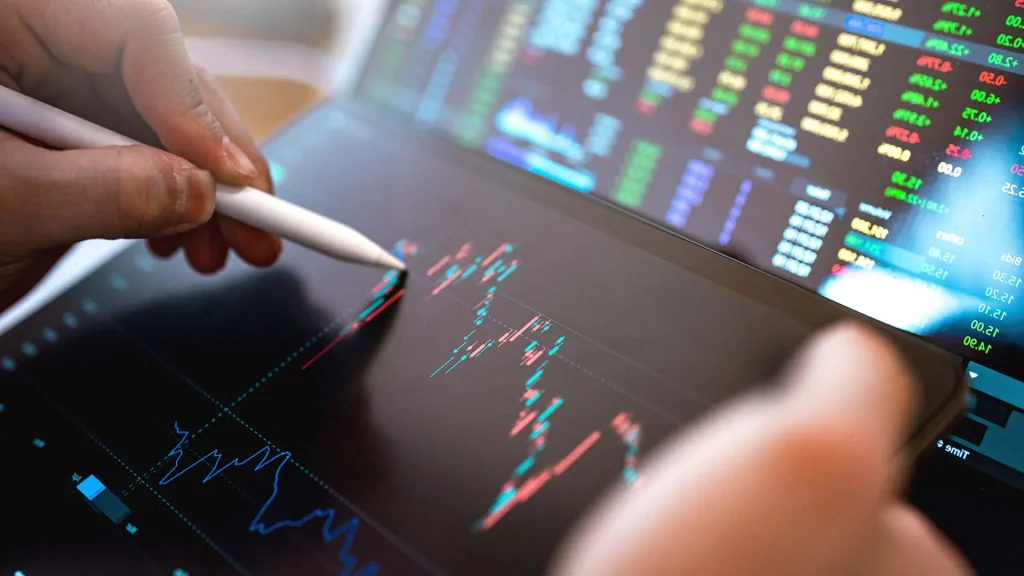What is technical analysis ?
⭐️ គន្លឹះសំខាន់
– ការវិភាគបែបបច្ចេកទេស គឺជាការសិក្សាអំពីតម្លៃដែលទ្រព្យមួយប្រភេទធ្លាប់ឡើងឬចុះទៅដល់ ដើម្បីកំណត់លំនាំ និងលទ្ធភាពនៃចលនារបស់ទ្រព្យថាវាអាចឡើងឬចុះដល់កម្រិតណានាពេលអនាគត ដោយប្រើប្រាស់សូចនាករបច្ចេកទេសនិងលំនាំតារាង។
– គោលដៅបំណងសំខាន់ៗបីនៃការវិភាគបច្ចេកទេស។
– ឧបករណ៍ជំនួយ និងបច្ចេកទេសដែលលោកអ្នកគួរប្រើក្នុងការវិភាគបែបបច្ចេកទេស
– ឯកសារយោង

⭐️ ស្វែងយល់ពីការវិភាគបែបបច្ចេកទេស
ការវិភាគបែបបច្ចេកទេស គឺជាការសិក្សាអំពីតម្លៃដែលទ្រព្យមួយប្រភេទធ្លាប់ឡើងឬចុះទៅដល់ ដើម្បីកំណត់លំនាំ និងលទ្ធភាពនៃចលនារបស់ទ្រព្យថាវាអាចឡើងឬចុះដល់កម្រិតណានាពេលអនាគត ដោយប្រើប្រាស់សូចនាករបច្ចេកទេសនិងលំនាំតារាង។ ការវិភាគបែបបច្ចេកទេសមិនមែនសម្រាប់វាស់ស្ទង់តម្លៃពិតប្រាកដរបស់ទ្រព្យសកម្មទេ ការវិភាគបែបនេះ តម្រូវឲ្យយើងមើលពីតម្លៃដែលទ្រព្យមួយប្រភេទធ្លាប់ឡើងឬចុះទៅដល់ និងរកចំណុចដែលយើងអាចចូលឬចេញពីទីផ្សារបាន ដោយប្រើសូចនាករបច្ចេកទេសផ្សេងៗ។
ភាពខុសគ្នាចម្បងរវាងការវិភាគបែបបច្ចេកទេស និងការវិភាគបែបមូលដ្ឋាន គឺការវិភាគបែបបច្ចេកទេសប្រើតែទិន្នន័យតម្លៃប្រវត្តិសាស្ត្ររបស់ទ្រព្យ និងទំហំនៃការជួញដូរឧបករណ៍និស្សន្ទតែប៉ុណ្ណោះ។
⭐️ គោលដៅបំណងសំខាន់ៗបីនៃការវិភាគបច្ចេកទេស
អ្នកវិនិយោគដែលប្រើការវិភាគបែបបច្ចេកទេសតែងតែមានគោលដៅ ៣ សំខាន់ៗ គឺ
- ពួកគាត់ចង់ទទួលបានប្រាក់ចំណេញពីការជួញដូរឧបករណ៍និស្សន្ទដោយសង្កេតមើលលំនាំទីផ្សារនិងស្ថិតិនៃទ្រព្យនិស្សន្ទនីមួយៗ។
- ពួកគាត់ចង់ស្វែងរកតម្លៃល្អៗសម្រាប់ការចូលនិងចេញពីទីផ្សារ។
- ជៀសវាងមិនឲ្យអារម្មណ៍របស់យើងគ្រប់គ្រងលើការសម្រេចចិត្តក្នុងការចូលផ្សាររបស់យើង។
⭐️ឧបករណ៍ជំនួយ និងបច្ចេកទេសដែលលោកអ្នកគួរប្រើក្នុងការវិភាគបែបបច្ចេកទេស
ទីផ្សារអាចធ្វើចលនាតែ៣ទិសតែប៉ុណ្ណោះគឺ ផ្សារអាចឡើង ផ្សារអាចចុះ ឬផ្សារអាចដើរចំហៀង ( Move sideways) ដូចនេះការវិភាគតាមបែបបច្ចេកទេសតម្រូវឲ្យយើងស្វែងរកនិន្នាការនៃផ្សារ ព្រមទាំងស្វែងរក support/resistance តាមរយៈការប្រើប្រាស់តារាងតម្លៃនិង/ឬតារាងពេលវេលា (Timeframe )។
ជាទូទៅតម្លៃតែងតែផ្លាស់ប្តូរក្នុងរបៀបហ្ស៊ីកហ្សាក់ ( Zigzag) ហើយសកម្មភាពតម្លៃមានពីរគឺ ៖
- Range: តម្លៃដែលទ្រព្យធ្វើចលនាទៅដល់នៅពេលផ្សារអាចដើរចំហៀង
- Trend: និន្នាការរបស់ផ្សារ នៅពេលដែលផ្សារដើរខ្ពស់ទៅៗ (uptrend) ឬ នៅពេលដែលផ្សារដើរទាបទៅៗ (downtrend)
ជាទូទៅ អ្នកដែលវិភាគតាមការវិភាគបែបបច្ចេកទេសតែងតែប្រើប្រាស់ធាតុសំខាន់ៗ៣ គឺ ៖
- សកម្មភាពតម្លៃ ៖ ការសិក្សាពីចលនាតម្លៃដែលទ្រព្យមួយប្រភេទធ្លាប់ឡើងឬចុះទៅដល់ ដើម្បីស្វែងរកតម្រុយថាផ្សារអាចឡើងឬចុះដល់ណាក្នុងពេលអនាគត។ គេអាចធ្វើបែបនេះបានដោយ ការគូរបន្ទាត់ (chart lines) ដើម្បីរកកន្លែងដែលតម្លៃទីផ្សារអាចដើរដល់។
- លំនាំនៃតារាង (chart pattern ) ៖ ស្វែងរកលំនាំលំហូរនៃក្រាបដើម្បីស្មានពីបម្រែបម្រួលតម្លៃនាថ្ងៃអនាគត។ លំនាំនៃតារាងក៏ត្រូវ បានគេប្រើដើម្បីរកទីតាំងដែលនិន្នាការអាចផ្លាស់ប្តូរ ( Trend reversal ) ឬ ការបន្តនៃនិន្នាការ ( Trend Continuation )។
- សូចនាករបច្ចេកទេស ៖ គេប្រើវាដើម្បីស្វែងរកសញ្ញាចូលទិញនិងលក់នៅក្នុងទីផ្សារ។ សូចនាករបច្ចេកទេសមួយចំនួនដែលគេតែងតែប្រើរួមមាន RSI, Stochastic oscillator, and Fibonacci retracements។ល។
⭐️ឯកសារយោង
Babypip: What is Technical Analysis? – BabyPips.com
Investopedia: Technical Analysis: What It Is and How to Use It in Investing (investopedia.com)
⏬English Below⏬
⭐️ Key takeaway
– Technical analysis is a method of analyzing the historical price action of an asset to determine the pattern and probability that an asset may move up or down in the future.
– The three main objectives of Technical analysis
– Tools and techniques used in Technical analysis
– References

⭐️Understanding Technical analysis
Technical analysis is a method of analyzing the historical price action of an asset to determine the pattern and probability that an asset may move up or down in the future. Technical analysis uses technical indicators and chart patterns to identify buy and sell entries in the market. It is important to note that technical analysis is not intended to measure the value of an asset, but rather to identify patterns and trends that can help traders make informed decisions.
The main difference between technical analysis and fundamental analysis is that technical analysis uses only historical price data of assets and the volume of trading.
⭐️The three main objectives of Technical analysis
Investors who use technical analysis always have three main objectives:
- They want to make a profit from derivatives trading by observing the market patterns and statistics of each derivative.
- They want to find good prices for entering and exiting the market.
- Avoid letting our emotions control our decision to enter the marketplace.
⭐️Tools and techniques used in Technical analysis
The market can only move in three directions: up, down, or sideways. Technical analysis requires finding the market trend and support/resistance through the use of charts, values, and/or timeframes.
In general, prices change in a zigzag mode with two price actions:
- Range: refers to the price at which the asset moves when the market moves sideways.
- Trend: refers to the market trend when it goes uptrend or downtrend.
In general, technical analysts often use three main elements:
- Price action: A study of the price movement in which an asset may have moved up or down to find out how the market may move up or down in the future. This can be done by drawing chart lines to find where the market value can reach.
- Chart pattern: Identifying major chart patterns of the graph to predict future price changes. This is also used to locate trends reversal or trend continuation.
- Technical Indicators: Used to find buy and sell entry or exit in the market. Some commonly used technical indicators include RSI, Stochastic oscillator, Fibonacci retracements, etc.
⭐️ References
Babypip: What is Technical Analysis? – BabyPips.com
Investopedia: Technical Analysis: What It Is and How to Use It in Investing (investopedia.com)

